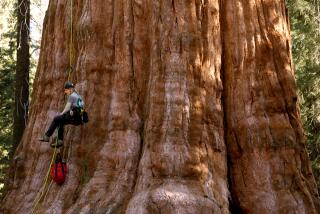Petrified Tree Stumps Punctuate Shoreline
- Share via
UNGA ISLAND, Alaska — If you want to stroll through the only forest in the Shumagin Islands, you have to wear rubber boots and wait until the tide goes out.
In the Shumagins, where the wind never seems to stop, only change directions, the few live trees were planted by people. But along a stretch of beach on the northwest corner of Unga Island, there’s a grove that hasn’t grown for millions of years.
Wind and water have worn away a 50-foot bluff to reveal a forest of petrified tree stumps that appear to be marching into the ocean.
“It’s like there was a great big Paul Bunyan -- chopped them off all even,” said Bill Dushkin, president of Shumagin Corp., the Alaska Native village corporation for Sand Point, which owns the land under the trees.
The trees are one of the oddities of Alaska, right up there with warm-blooded dinosaur fossils found north of the Brooks Range on the North Slope. The trees are believed to be sequoia, which grow in Northern California, or metasequoia, now found mainly in China. Neither have any business being so far north.
Unga is the largest of the dozen or so Shumagin Islands, 570 miles southwest of Anchorage near the tip of the Alaska Peninsula.
The petrified forest, much of it below the tide line, covers about five miles of beach. On a sunny day, the petrified tree stumps stand out white and bright against the gray-black beach rock. From the bluff, they look like marshmallows spilled out on charcoal. The stumps range in diameter from a couple of feet to about 9 feet across.
Hardly anybody visits this part of Unga. A small airplane can land a mile away, but the few people who visit usually come by skiff. On a sunny summer day, with the mountains of the Alaska Peninsula as a backdrop six miles away, the only sound was the beating of a raven’s wings and the occasional breaker washing against beach rocks.
Bruce Giffen, a geologist with the National Park Service, said the trees were a product of the Miocene or Oligocene epochs about 25 million years ago, when paleontologists believe that the Earth was warmer and the first horses and elephants with trunks emerged.
The trees were toppled by a lahar, a flow of ash and coarser products mixed with water that was pushed out in the form of a mud flow by a volcanic eruption.
“Flow from the volcano came down and engulfed those trees and basically snapped them off at their stumps, or somewhere in the height of the trees,” Giffen said.
The lahar may have been a big area of mud that destabilized on a steep slope.
“It doesn’t necessarily have to be hot, but they certainly can be hot,” he said. And his guess is that the material was.
“There’s very little in the way of leaves or needles,” he said, indicating that those parts may have burned.
The mud snapped off the trees and encased them. Over millions of years, the organic material of the trees was replaced by minerals seeping in and taking their design.
Different minerals turned the trees a different color. Some are studies in slate and white. Some are cream, red or orange.
No one knows how far inland the petrified forest extends. High in the bluff, additional trees are emerging.
One of the largest is on the beach, a preserved log 67 paces long.
Dushkin first saw the trees as a boy on a trip to dig razor clams. When villages were allowed to claim federal land under the Alaska Native Claims Settlement Act, the Shumagin Corp. chose this part of Unga.
Dushkin is a commercial fisherman, but he says even he can tell that the geology of Shumagins is different from what’s on the nearby Alaska Peninsula.
“It’s not the same as the stuff you get on the mainland,” he said. “It’s like apples and oranges.”
Dushkin sees tourism possibilities in the forest. His corporation owns the only hotel in Sand Point, a city of about 1,000 a 30-minute boat ride away. Dushkin would like to attract visitors in the months when the area’s main source of dollars, commercial fishing, has slowed.
So far, only a few small cruise ships stop at the petrified forest. One of them is the Clipper Odyssey leased by Zegrahm Expeditions, an adventure tour company based in Seattle.
Zegrahm President Scott Fitzsimmons said Unga would be a stop for a cruise that started in Nome and visited islands in the Bering Sea.
Visitors took inflatable boats to Unga to see the petrified forest, bird rookeries or the abandoned Unga town site.
“They’re looking for an education experience,” Fitzsimmons said.
The cruise ship’s lecturers are augmented by Shumagin Corp. members hired as guides.
Dushkin believes that visitors may someday see the forest through glass-bottom boats. He has approached the beach in his fishing boat, with radar indicating something on the ocean floor 12 to 18 feet high, rising like posts.
“I think there are underwater trees there,” he said.
More to Read
Sign up for The Wild
We’ll help you find the best places to hike, bike and run, as well as the perfect silent spots for meditation and yoga.
You may occasionally receive promotional content from the Los Angeles Times.






